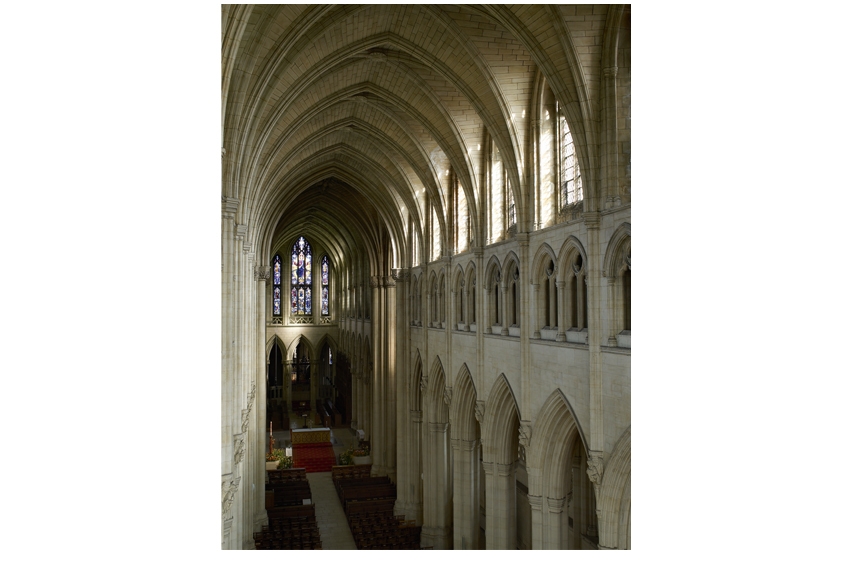It was in 1814 that the Benedictine monks arrived in Stratton-on-the-Fosse in Somerset from Douai in Flanders where, in 1606, they had established an exiled, but English, monastic house. They were forced to leave the Continent in 1795 after revolutionary France had declared war on England. They wandered a bit until they finally bought a decent house built in 1700 and a farmhouse with 21 acres at Downside. This book tells a complicated saga of the building of the present abbey and school that will enthral those readers fascinated by the morphology of the Gothic Revival. But it could appeal equally to those gripped by the ultra-montane tendencies in the history of English Catholic life.
Downside Abbey’s church tower is what first strikes any visitor. It is some 166 feet high (55 metres) and the church itself is the largest neo-Gothic church built in England since the Reformation. Sir Nikolaus Pevsner admired it and thought the use of the Gothic style represented ‘a splendid demonstration of the renaissance of Roman Catholicism in England’. The present and 12th abbot of Downside, Dom Aidan Bellenger, who has edited this selection of learned essays, would certainly agree, while stressing that throughout the building process it was the need for an atmosphere of calm prayerfulness that architects were asked to provide for the monks, who will spend up to three hours of every day in the church.
The abbot has contributed two essays; one on models of monasticism and another focused on the aesthetic contribution of two men, the church architect Ninian Comper who worked at Downside until 1951 and the architect Frederick Walters.
The other six essays are written by scholars covering the architectural development in more or less chronological order from the earliest days to the present. Three essays stand out. The first by Michael Hall gets to grips with the achievement of the building of the magnificent choir by the catholic convert architect Thomas Garner which was dedicated in 1905. Hall clarifies the emotional and religious debates of the period as they affected architecture. It is a kind of theological detective story, ending with an account of the design of a chapel dedicated to St Sebastian paid for by a Jewish, homosexual convert to Catholicism.
Gavin Stamp also has the gift of writing about somewhat arcane architectural stylistic debates so that they become utterly fascinating. Stamp is an expert on the career of Sir Giles Gilbert Scott and he rightly says that it is Scott’s contribution of the great nave, the heightening of the tower and the design of several monuments and furnishings, that elevate the abbey church to a level of magnificence. What a disappointment that there is no illustration of Scott’s final design to complete the church. Instead we are treated to full-page dull photographs of the unfinished west end.
Scott brought the sculptor who worked with him on Liverpool’s Anglican cathedral to Downside to create the amazing Deco-Gothic tomb of one of the key figures in the abbey’s history, Cardinal Gasquet. What a mistake not to put in a photograph of the complete tomb and canopy.
The third intriguing essay is by Alan Powers and deals with the post-war decades and particularly the work of two modern architects, Francis Pollen and Lionel Brett, later third Viscount Esher. While the monks retained their conservative tastes they were persuaded that the rough concrete of the New Brutalism was utterly appropriate for the new library where Pollen placed an octagon on a square base, creating a fortress-like building which Powers generously compares to the Castel Sant’Angelo neighbouring the Vatican.
Powers is one of the few critics prepared to examine objectively the sources of the peculiarly British modern architecture of the1960s and 1970s, and Downside’s buildings of that time deserve his scholarly analysis. He rightly also draws attention to the remarkable church at Worth —the sister house of Downside — also designed by Francis Pollen.
While this book is technically an illustrated architectural history, it is also an insight into the Benedictine world and the delicate nature of community decision-making. St Benedict did not have anything very significant to say about architecture; he simply wanted places of prayer, where even architectural historians could contemplate the shape of the world to come.






Comments